Goat Farm Lighting: Effect of Photoperiod on Milk Production in Dairy Goats
Goat Farm Lighting: Effect of Photoperiod on Milk Production in Dairy Goats
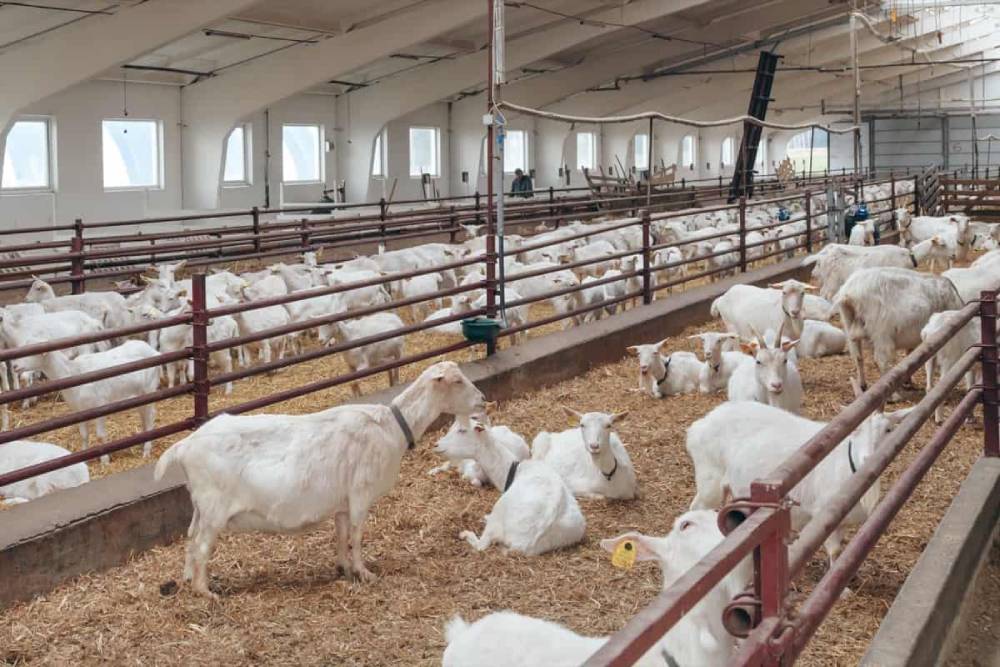
Directory:
1. Materials and Methods
2. Results and Analysis
3. Discussion
In recent years, dairy goats have experienced consistent growth and promising market potential globally, gaining increasing appreciation and popularity among consumers. Goat milk is recognized for its unique nutritional benefits and wide market appeal. Often referred to as the "king of milk," goat milk is seen as a premium natural supplement by consumers in developed regions of China, such as Guangdong and Fujian. It has emerged as a popular choice in the dairy market, leading to a supply shortage. The price of fresh goat milk can reach between 10 to 16 yuan per kilogram. Additionally, goat milk cheese is a nutritious option favored by consumers in Europe and America. With rising living standards, dairy products like cheese and yogurt have also gained popularity among many domestic consumers. Overall, the future of the goat milk market looks very promising.
Among the environmental factors that can be controlled, light is relatively easy to manage in practice. Research indicates that light can directly influence the physiological functions of animals, impacting the performance and productivity of livestock and poultry. In poultry farming, extending light exposure has significantly boosted egg production rates. Both domestic and international researchers have conducted lighting studies on dairy cows, revealing that lighting can affect milk yield, feed consumption, and milk fat content. The author investigated the impact of lighting on the lactation performance of dairy goats and assessed its economic advantages.
1. Materials and Methods
1.1 Experimental Animals and Grouping
The study involved 12 Laoshan dairy goat ewes, each weighing (52.65 ± 5.60) kg, with 2 parities, comparable daily milk yields, synchronized lambing dates, and all in a healthy peak lactation phase. The ewes were randomly assigned to three groups, with four animals in each. Group A served as the control group, exposed to natural light, while Groups B and C were the experimental groups. These two groups received additional artificial lighting, extending their daylight exposure to 13 hours for Group B and 16 hours for Group C. The total duration of the experiment was 30 days, which included a 5-day pre-test phase followed by a 30-day testing phase. The production performance of the Laoshan dairy goats prior to the experiment is detailed in Table 1.
table1 Production performance of Laoshan dairy goats before the experiment
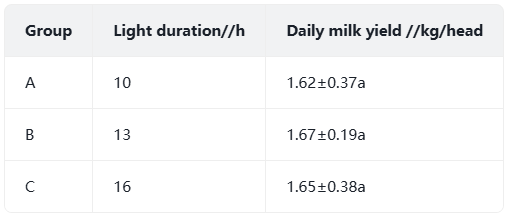
1.2 Feeding Management
The diet for dairy goats includes whole plant silage, pellet feed, apple pomace, distiller's grains, peanut vines, hay (dried corn stalks), and baking soda (as shown in Table 2). The concentrate consists of corn, soybean meal, peanut meal, cottonseed meal, corn germ meal, vegetable oil, stone powder, calcium hydrogen phosphate, salt, lysine, methionine, choline chloride, vitamins A, D3. E, copper sulfate, manganese sulfate, zinc sulfate, and ferrous sulfate, among others. This is the 710 dairy cow milking feed produced by Laiyang Dehui Feed Co., Ltd. All groups had access to fresh drinking water and were subjected to identical feeding and management conditions.
Each group of experimental dairy goats was housed in separate sheep pens. After morning milking, they were allowed to roam freely in a playground and were returned to the sheep shed at 5:00 PM. They were fed four times daily at 5:30 AM, 9:30 AM, 3:30 PM, and 7:30 PM, with a total daily feed amount of 1.26 kg per goat. A designated individual monitored the health of the dairy goats daily. They were milked twice a day at 6:30 AM and 6:00 PM, with daily milk production recorded and milk quality assessed every five days.
table2 Feed composition and ratio
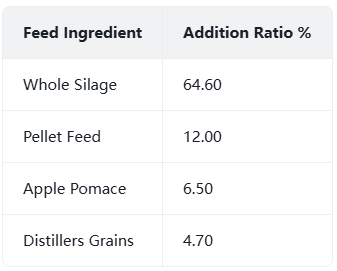
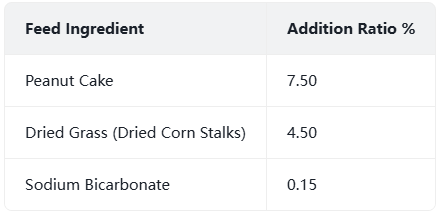
1.3 Experimental Duration and Location
The experiment took place at Aote Sheep Farm in Qingdao, Shandong Province, from December 21. 2013. to January 25. 2014. spanning a total of 35 days. This included a 5-day pre-test phase and a 30-day testing phase. During the testing period, natural light was available from 7:00 AM to 5:00 PM, totaling 10 hours.
1.4 Testing Methodology
Fluorescent lamps were installed in the dairy goat housing based on the area size to achieve a light intensity of 150-200 lx/m2. Group B received an additional 3 hours of artificial light daily, resulting in a total light duration of 13 hours; Group C received an extra 6 hours, leading to a total of 16 hours of light; while Group A relied solely on natural light.
During the first five days of the pre-test phase, Groups A and B turned on the lights at 5:30 AM until sunrise and again at sunset, gradually extending the light duration. By the fifth day, the total duration of artificial and natural light for Groups A and B reached 13 and 16 hours, respectively, with lights being turned off at 6:30 PM and 9:30 PM. This lighting schedule was maintained for the remainder of the trial period. The control group of dairy goats only received natural light without any additional lighting.
1.5 Indicators and Methods for Determination
Mechanical milking (pipeline type) was conducted twice daily at 6:30 am and 6:00 pm, with daily records of milk production. Every five days, 25 ml milk samples were collected in the morning and evening at the start of the formal trial, mixed thoroughly, and stored in a refrigerator at 4 ℃. After adequate mixing, the milk quality was analyzed using a milk component analyzer. The analysis took place at Qingdao Jiaozhou District New Hope Qinpai Dairy Co., Ltd., and the indicators measured included milk protein, milk fat, total dry matter, non-fat milk, lactose, specific gravity, and freezing point.
1.6 Data Processing
The experimental data were organized using Excel 2003. and statistical analysis and graphing were performed with Graph-Pad software and Excel 2003. The F test was utilized for multiple group comparisons. The results of the experiment are presented as "mean ± standard deviation."
2. Results and Analysis
2.1 Effect of Light Exposure Duration on Dairy Goat Milk Production
As indicated in Table 3. the average daily milk production in group B surpassed that of control group A and experimental group C, with a highly significant difference (P <0.01). Additionally, experimental group C produced more milk than control group A, although this difference was not significant (P>0.05). An increase in sunlight duration led to higher milk production, with group B showing a more substantial increase compared to group C, and this difference was highly significant (P<0.01).
table3 Effect of photoperiod on milk production in dairy goats
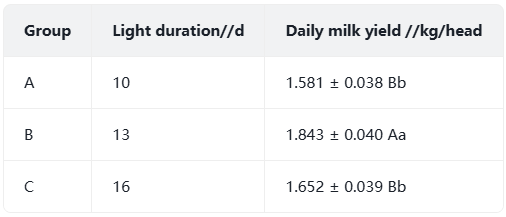
2.2 Effect of Light Exposure Duration on Key Milk Components in Dairy Goats
After extending the duration of light exposure, the milk fat percentage in groups B and C did not differ significantly from that of group A (P>0.05). Regarding milk protein percentage, group B showed no significant difference compared to group A (P>0.05), but group C had a significantly higher protein percentage than group A (P<0.05). For total dry matter content and non-fat milk percentage, groups B, C, and A exhibited no significant differences (P>0.05). In terms of lactose content, group B did not differ significantly from group A (P>0.05), whereas group C had a significantly higher lactose content than group A (P<0.01).
2.3 Effect of Photoperiod on Milk Production and Economic Advantages of Dairy Goats
Group B experienced a daily photoperiod of 13 hours, resulting in an average increase of approximately 0.25 kg of milk per goat per day. With this increase, the revenue from the additional 0.25 kg of milk amounted to 2.0 yuan (given that the price of goat milk is 10 yuan/kg). The electricity cost for using a 40 W bulb for 3 hours was 0.06 yuan (at a rate of 0.5 yuan/kW·h), and other expenses totaled 0.24 yuan. Consequently, the daily income per goat rose by about 1.7 yuan. Over a winter period of 3 months, the artificial lighting for dairy goats led to a net income increase of 153 yuan. For a farm with 100 dairy goats, this could result in a total net income boost of 15.300 yuan during winter.
In Group C, which had 16 hours of light daily, the average milk production per goat increased by around 0.06 kg per day. With an additional 6 hours of light, the extra milk production of 0.09 kg generated 0.6 yuan in revenue (at the same milk price of 10 yuan/kg). The electricity cost for 6 hours of a 40 W bulb was 0.12 yuan, and other expenses remained at 0.24 yuan. Thus, the daily income per goat increased by 0.24 yuan. Over the winter months, the artificial lighting for these goats resulted in a net income increase of 21.6 yuan. For a medium-sized goat farm with 100 dairy goats, this could lead to a total net income increase of 2.160 yuan during winter. It is important to note that while there is a certain increase in milk production, the overall benefits are largely influenced by the prevailing price of fresh milk at that time.
3. Discussion
Previous research has shown that animals, particularly dairy cows, are significantly affected by light. It was once thought that dairy cows are highly sensitive to light. Studies indicate that when light exposure is gradually increased from 8 hours to 16 hours, the serum prolactin levels rise by approximately four times. Conversely, reducing natural light exposure from 15 hours to 8 hours results in an 86% decrease in prolactin levels. Thus, additional light enhances serum prolactin levels, which in turn boosts milk secretion and production. Furthermore, light exposure can stimulate the release of thyrotropin-releasing hormone via the pineal gland and hypothalamus, increasing the pituitary gland's responsiveness to this hormone, leading to changes in the body's endocrine system that promote lactation and enhance milk output. Additionally, increased milk production results in higher food intake among dairy cows, rather than simply an increase in light exposure prompting them to consume more feed, which ultimately boosts milk production. Research has shown that when cows' eyes are exposed to light, the initial response is to send signals that inhibit melatonin release. A decrease in melatonin levels in dairy cows can impact the secretion of other hormones, such as insulin-like growth factor (IGF-1). Elevated IGF-1 levels promote mammary gland secretion, further increasing milk production.
Similarly, extending light exposure can also influence egg production in chickens. Studies have demonstrated that appropriate light exposure can enhance egg production in laying hens and improve blood circulation in chicks. This is attributed to an increase in appetite, which accelerates weight gain in broilers. Additionally, it aids in the metabolism of calcium and phosphorus and boosts the immune system of chicks.
Research has indicated that the ovulation rate in dairy goats can be influenced by light exposure. Specifically, when dairy goats are exposed to 16 hours of light per day for a month, their ovulation rate significantly surpasses that of goats undergoing hormone-induced estrus. Additionally, increasing light exposure during the non-breeding season can notably enhance both the estrus rate and ovulation in goats. These findings suggest that light exposure affects the production traits of various livestock, including dairy cows, chickens, and sheep.
In an experiment, artificially extending the light duration to 13 hours per day during the winter lactation period resulted in a roughly 16.6% increase in milk production for dairy goats, while parameters like milk fat content and total dry matter remained comparable to the control group. This indicates that enhancing light intensity can substantially boost the economic returns of dairy goat farming. Further investigation is needed to determine if the mechanism behind increased milk production due to heightened light intensity is similar to that observed in dairy cows.
